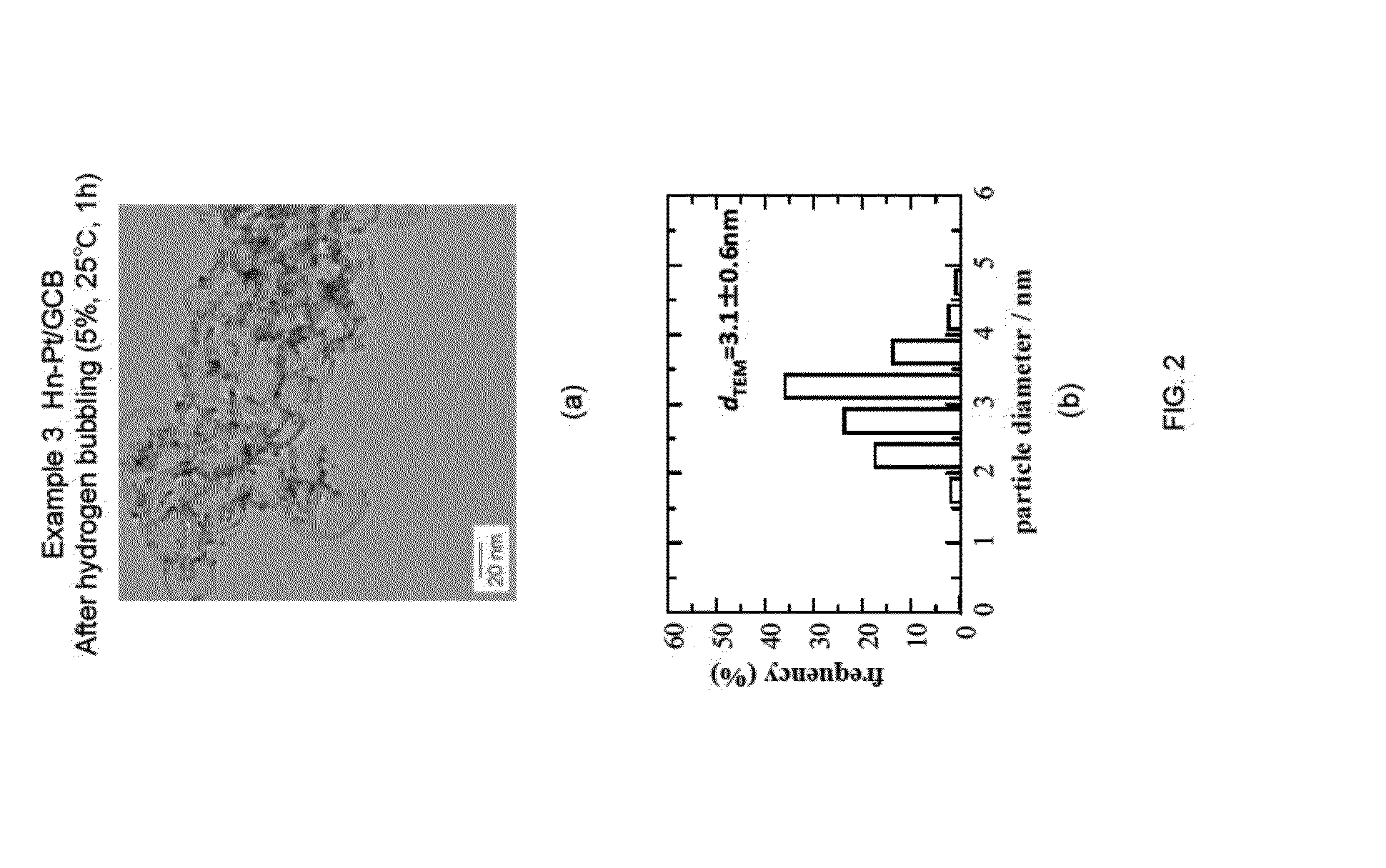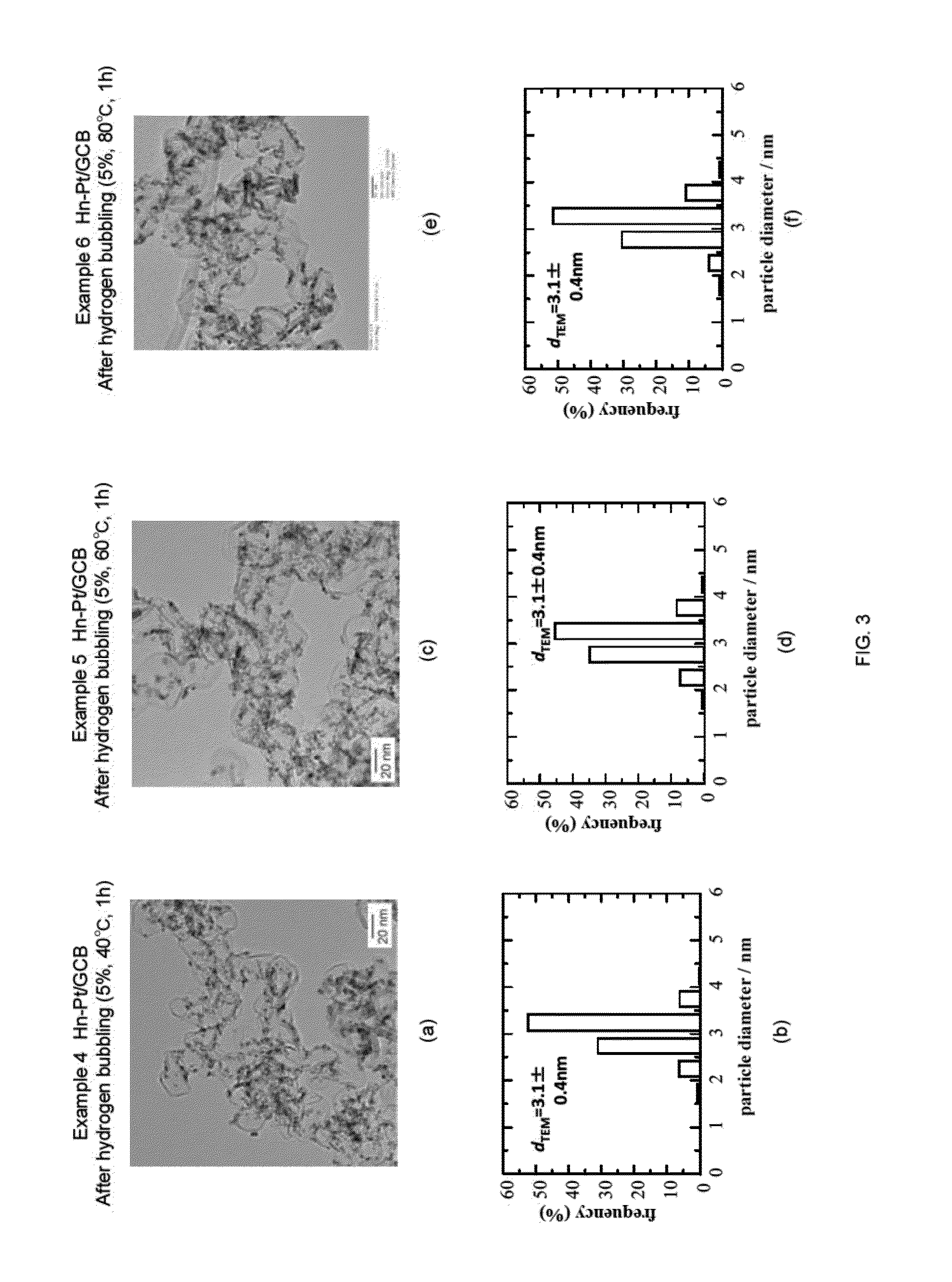Production method for fine metal particles, production method for fuel cell electrode catalyst, supported fine metal particle catalyst, and fuel cell electrode catalyst
a production method and technology for fuel cells, applied in cell components, active material electrodes, transportation and packaging, etc., can solve the problems of complex process, unhomogeneous catalyst particle diameter, and inability to meet the requirements of production, so as to reduce the cost of raw materials, reduce the effect of reaction and reduce the manufacturing cos
- Summary
- Abstract
- Description
- Claims
- Application Information
AI Technical Summary
Benefits of technology
Problems solved by technology
Method used
Image
Examples
example 1
1. Example 1
n-Pt / GCB+Pt Skin (Hn-Pt / GCB), 100% Hydrogen Bubbling, 60° C., 3 h
[0085]1-1. Preparation of n-Pt / GCB
[0086]Pt(acac)2 (0.125 mmol, 49 mg), 1,2-hexadecanediol (1 mmol, 260 mg), and diphenyl ether (12.5 ml, 13.5 g, 79.3 mmol) were charged in a beaker, and the mixture was agitated and mixed for 10 minutes at an elevated temperature of 100° C. using a stirrer. Subsequently, oleic acid (0.25 mmol, 85 μl) and oleylamine (0.25 mmol, 80 μl) were added, and the temperature was raised to 200° C. with agitation. Then, the mixture was further agitated for 20 minutes to give a nano-capsule solution. To the nano-capsule solution thus obtained, 1M LiB(C2H5)3H·THF solution (1.0 ml, 1 mmol) was added dropwise over 2 minutes, and the mixture was agitated for 5 minutes. Then, the temperature of the mixture was raised to 260° C., and the reduction reaction was carried out at this temperature under reflux for 20 minutes. Accordingly, solution A containing Pt particles in the nano-capsule was ob...
example 2
2. Example 2
n-Pt / GCB+Pt Skin (Hn-Pt / GCB), 100% Hydrogen Bubbling, 25° C., 3 h
[0093]The temperature of the reaction solution during the hydrogen bubbling was altered to 25° C., and the experiment and evaluation were performed in a similar manner as Example 1. The results are shown in FIG. 1(e) to (f). As shown in FIG. 1(e), it can be understood that the particle diameter of each of the Pt fine particles supported on GCB were made large. In addition, as shown in FIG. 1(f), the average particle diameter dTEM was increased by approximately 0.6 nm. These results show that reduction reaction of the Pt skin precursor occurred by hydrogen bubbling even at a low temperature as 25° C., thereby forming the Pt skin layer.
example 3
3. Example 3
n-Pt / GCB+Pt Skin (Hn-Pt / GCB), 5% Hydrogen Bubbling, 25° C., 1 h
[0094]In Example 3, the conditions for the hydrogen bubbling were altered to a hydrogen concentration of 5%, a temperature of 25° C., and the time period of 1 hour, and the experiment and evaluation were performed in a similar manner as Example 1. The results are shown in FIG. 2(a) to (b). As shown in FIG. 2(a), it can be understood that the particle diameter of each of the Pt fine particles supported on GCB were made large. In addition, as shown in FIG. 2(b), the average particle diameter dTEM was increased by approximately 0.9 nm. These results show that almost total amount of the Pt skin precursor were reduced and consumed for the formation of the Pt skin layer, even when the hydrogen bubbling was conducted under the conditions of low concentration, low temperature, and short time, such as hydrogen concentration of 5%, temperature of 25° C., and time period of 1 hour.
PUM
| Property | Measurement | Unit |
|---|---|---|
| particle diameter | aaaaa | aaaaa |
| particle diameter | aaaaa | aaaaa |
| temperature | aaaaa | aaaaa |
Abstract
Description
Claims
Application Information
 Login to View More
Login to View More - R&D
- Intellectual Property
- Life Sciences
- Materials
- Tech Scout
- Unparalleled Data Quality
- Higher Quality Content
- 60% Fewer Hallucinations
Browse by: Latest US Patents, China's latest patents, Technical Efficacy Thesaurus, Application Domain, Technology Topic, Popular Technical Reports.
© 2025 PatSnap. All rights reserved.Legal|Privacy policy|Modern Slavery Act Transparency Statement|Sitemap|About US| Contact US: help@patsnap.com



